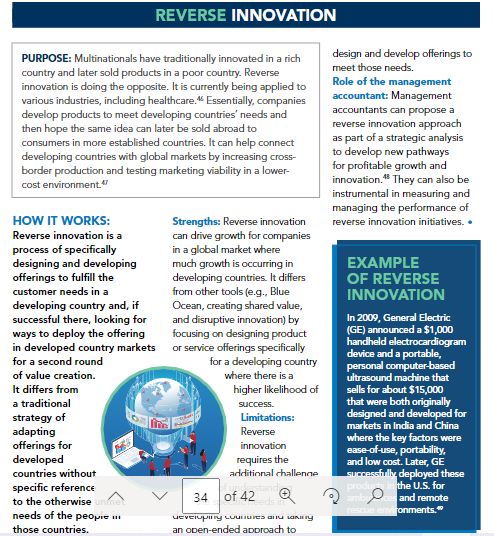Explain the picture below. strengths, limitation, and role of management accountant
Explain the picture below. strengths, limitation, and role of management accountant
Chapter6: International Management
Section6.6: Strategies For Expanding Globally
Problem 1DQ: Why did Bayer Crop Science decide to move from its original regional organization of units to a more...
Related questions
Question
Explain the picture below.
- strengths,
- limitation, and
- role of management accountant

Transcribed Image Text:REVERSE INNOVATION
PURPOSE: Multinationals have traditionally innovated in a rich
country and later sold products in a poor country. Reverse
innovation is doing the opposite. It is currently being applied to
various industries, including healthcare. Essentially, companies
develop products to meet developing countries' needs and
then hope the same idea can later be sold abroad to
consumers in more established countries. It can help connect
developing countries with global markets by increasing cross-
border production and testing marketing viability in a lower-
cost environment."
design and develop offerings to
meet those needs.
Role of the management
accountant: Management
accountants can propose a
reverse innovation approach
as part of a strategic analysis
to develop new pathways
for profitable growth and
innovation." They can also be
instrumental in measuring and
managing the performance of
HOW IT WORKS:
Strengths: Reverse innovation
can drive growth for companies
in a global market where
much growth is occurring in
developing countries. It differs
from other tools (e.g., Blue
Ocean, creating shared value,
and disruptive innovation) by
focusing on designing product
in developed country markets or service offerings specifically
for a developing country
reverse innovation initiatives. •
Reverse innovation is a
process of specifically
designing and developing
offerings to fulfill the
customer needs in a
developing country and, if
successful there, looking for
ways to deploy the offering
EXAMPLE
OF REVERSE
INNOVATION
In 2009, General Electric
(GE) announced a $1,000
handheld electrocardiogram
device and a portable,
personal computer-based
ultrasound machine that
sells for about $15,000
that were both originally
designed and developed for
markets in India and China
where the key factors were
ease-of-use, portability,
and low cost. Later, GE
Successfully deployed these
produ in the U.S. for
ambu
for a second round
of value creation.
where there is a
It differs from
higher likelihood of
a traditional
success.
strategy of
adapting
offerings for
developed
Limitations:
Reverse
innovation
requires the
countries without
additional challenne
specific reference
to the otherwise
34 of 42
and remote
needs of the peopie
rescue environments."
those countries.
an open-ended aporoach to

Transcribed Image Text:strategy of
adapting
offerings for
developed
designed and developed for
markets in India and China
where the key factors were
ease-of-use, portability,
and low cost. Later, GE
successfully deployed these
products in the U.S. for
ambulances and remote
Limitations:
Reverse
innovation
requires the
additional challenge
countries without
specific reference
of understanding
the specific needs in
developing countries and taking
an open-ended approach to
to the otherwise unmet
rescue environments."
needs of the people in
those countries.
Expert Solution
This question has been solved!
Explore an expertly crafted, step-by-step solution for a thorough understanding of key concepts.
Step by step
Solved in 3 steps

Recommended textbooks for you

